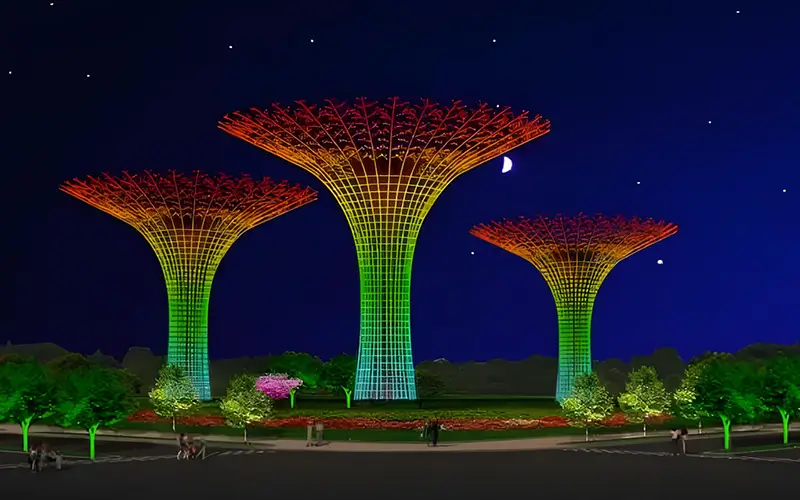
In the field of lighting and stage effects, DMX512&SPI LED light strips must be the first choice. However, you need to match colorful LED LED strips with corresponding controllers. The DMX512 controller then serves as a key tool, completely changing how lighting is controlled and operated. It is a versatile device that enables users to easily create dynamic lighting effects and synchronize multiple lamps.
What is a DMX512 Controller?
A DMX512 controller is the brain of a DMX lighting system, responsible for generating and transmitting digital control signals. This controls the behavior of compatible lighting devices. These signals enable users to control up to 512 lighting channels simultaneously.
Each channel represents an individual lighting property, such as intensity, color or position, allowing for a large number of customizable effects. You can adjust them to your needs.
Widely regarded as the industry standard for lighting control, DMX512 controllers provide precise and reliable management of complex lighting setups. About the DMX512 lighting, pls read What Does DMX Stand for Lighting?
Technical Details of DMX512 Controllers
Technically, DMX512 controller operates by sending a series of data packets to send information in a specific format. Each DMX controller has a limited number of channels, which determines the number of lights or individual light parameters it can control.
1. DMX512 protocol
- Data transmission method: DMX512 uses one-way data transmission, that is, the controller sends data to the lamp, but the lamp does not feedback status information.
- Cable: A standard 3-pin or 5-pin XLR connector transmits DMX512 control data, requiring high-quality shielded cables to avoid interference.
2. Control channel and address
- 512 channels: Each DMX512 controller can control up to 512 channels, which can adjust a specific function (such as color, brightness, etc.).
- Address allocation: Each DMX device is assigned a unique starting address to avoid confusion with other signals. The address range is from 1 to 512, but depending on the device’s function, multiple consecutive channels may be occupied.
3. Data rate and update frequency
- Rate: DMX512 data is transmitted at a fixed rate of 250 Kbps, which is a relatively high speed, making DMX control responsive in real-time.
- Frame rate: The data frame rate of DMX512 usually runs around 40Hz. This means the system transmits about 40 frames of data per second. This frame rate is sufficient to achieve smooth lighting changes.
4. Data frame structure
- Frame content: Each frame contains 513 bytes of data, of which the first byte is the start code and the subsequent 512 bytes are channel data.
- Channel data: Each channel data occupies one byte, ranging from 0 to 255. This data range allows 256 levels of precise adjustment of the brightness, color and other properties of the lamp.
5. DMX512 control mode
- Master-slave mode: In master-slave mode, a DMX controller acts as a master controller to control multiple slave devices, and each slave device executes according to the master device signal.
- Independent mode: In independent mode, the DMX controller presets multiple lighting scenes and can run independently without connecting to external devices.
6. DMX512 and RGB, RGBW, RGBIC light control
- RGB/RGBW control: Each RGB channel controls red, green, and blue respectively, and RGBW adds a white channel to obtain richer color selection and brightness control. What is an RGB LED Strip Used For?
- RGBIC control: RGBIC light strips support individual control of each LED node, and DMX512 can achieve detailed color changes by cooperating with specific decoders.
Applications of DMX512 Controller
- The versatility of DMX512 controllers makes them indispensable equipment in the lighting industry. They are widely used in theaters, concerts, building facades, and bridges, and can create very stunning visual effects.
- Stage lighting: DMX512 is one of the main choices for stage lighting control. It can control multiple lamps synchronously and is suitable for dynamic lighting effects.
- Architectural lighting: In architectural landscape lighting, DMX controllers can accurately adjust color and brightness. Which is suitable for large-area architectural projection lighting.
- Smart home: Smart home systems integrate DMX controllers, enabling users to customize home atmosphere lighting and combine RGB light strips to create rich lighting effects.
Advantages of DMX512 Controller
One of the main advantages of DMX512 controllers is their precision and flexibility. With the ability to control each lighting channel independently, DMX controllers are highly scalable, so the lighting system can be expanded as demand grows.
In addition, the standardization of the DMX512 protocol has another great feature. It ensures compatibility between different brands and models of lighting equipment, thus simplifying system integration and reducing the risk of incompatibility issues.
Programming and Customization Of DMX512 Controller
The core appeal of DMX512 controllers lies in their programming and customization capabilities. Users can create custom lighting scenes, sequences, and effects using dedicated software or programming directly on the controller.
Users can save and recall these programs as needed, providing a fast and efficient way to switch between different lighting setups. In addition, many controllers support third-party scripting languages, enabling advanced users to create truly unique and complex lighting effects.
The level of customization offered by DMX512 controllers is virtually limitless, making them a top choice for professionals seeking maximum control over their lighting systems.
Summary
DMX512 controller is an indispensable tool for lighting professionals, it is compatible with most lighting systems. If you are looking for DMX LED strips, DMX neon strips and DMX controllers, please contact us. Our all LED strips and neon flex are guaranteed for 5 years.
